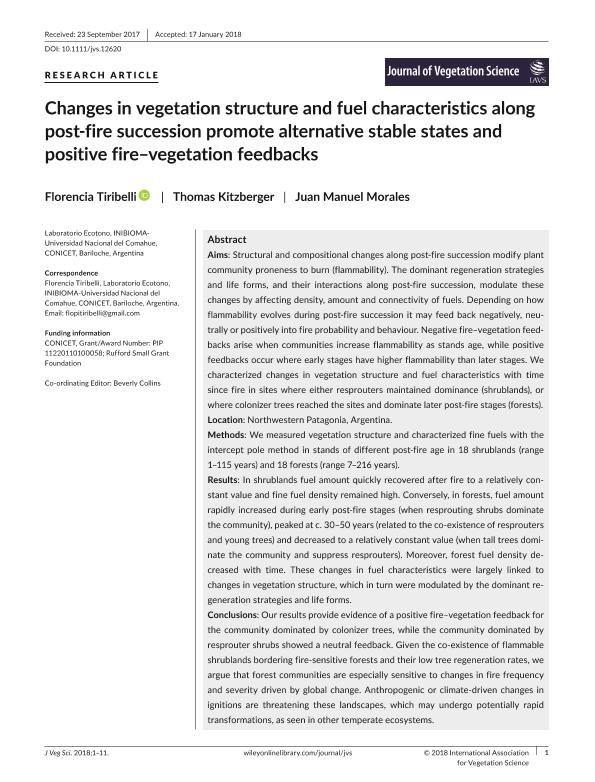Mostrar el registro sencillo del ítem
dc.contributor.author
Tiribelli, Florencia

dc.contributor.author
Kitzberger, Thomas

dc.contributor.author
Morales, Juan Manuel

dc.date.available
2020-01-09T19:03:53Z
dc.date.issued
2018-03
dc.identifier.citation
Tiribelli, Florencia; Kitzberger, Thomas; Morales, Juan Manuel; Changes in vegetation structure and fuel characteristics along post-fire succession promote alternative stable states and positive fire–vegetation feedbacks; Wiley Blackwell Publishing, Inc; Journal of Vegetation Science; 29; 2; 3-2018; 147-156
dc.identifier.issn
1100-9233
dc.identifier.uri
http://hdl.handle.net/11336/94177
dc.description.abstract
Aims: Structural and compositional changes along post-fire succession modify plant community proneness to burn (flammability). The dominant regeneration strategies and life forms, and their interactions along post-fire succession, modulate these changes by affecting density, amount and connectivity of fuels. Depending on how flammability evolves during post-fire succession it may feed back negatively, neutrally or positively into fire probability and behaviour. Negative fire–vegetation feedbacks arise when communities increase flammability as stands age, while positive feedbacks occur where early stages have higher flammability than later stages. We characterized changes in vegetation structure and fuel characteristics with time since fire in sites where either resprouters maintained dominance (shrublands), or where colonizer trees reached the sites and dominate later post-fire stages (forests). Location: Northwestern Patagonia, Argentina. Methods: We measured vegetation structure and characterized fine fuels with the intercept pole method in stands of different post-fire age in 18 shrublands (range 1–115 years) and 18 forests (range 7–216 years). Results: In shrublands fuel amount quickly recovered after fire to a relatively constant value and fine fuel density remained high. Conversely, in forests, fuel amount rapidly increased during early post-fire stages (when resprouting shrubs dominate the community), peaked at c. 30–50 years (related to the co-existence of resprouters and young trees) and decreased to a relatively constant value (when tall trees dominate the community and suppress resprouters). Moreover, forest fuel density decreased with time. These changes in fuel characteristics were largely linked to changes in vegetation structure, which in turn were modulated by the dominant regeneration strategies and life forms. Conclusions: Our results provide evidence of a positive fire–vegetation feedback for the community dominated by colonizer trees, while the community dominated by resprouter shrubs showed a neutral feedback. Given the co-existence of flammable shrublands bordering fire-sensitive forests and their low tree regeneration rates, we argue that forest communities are especially sensitive to changes in fire frequency and severity driven by global change. Anthropogenic or climate-driven changes in ignitions are threatening these landscapes, which may undergo potentially rapid transformations, as seen in other temperate ecosystems.
dc.format
application/pdf
dc.language.iso
eng
dc.publisher
Wiley Blackwell Publishing, Inc

dc.rights
info:eu-repo/semantics/openAccess
dc.rights.uri
https://creativecommons.org/licenses/by-nc-sa/2.5/ar/
dc.subject
FINE FUELS
dc.subject
FLAMMABILITY
dc.subject
NOTHOFAGUS
dc.subject
POST-FIRE COLONIZER
dc.subject
POST-FIRE RESPROUTER
dc.subject
PYROPHOBIC FORESTS
dc.subject
PYROPHYTIC SHRUBLANDS
dc.subject
TIME SINCE FIRE
dc.subject.classification
Ecología

dc.subject.classification
Ciencias Biológicas

dc.subject.classification
CIENCIAS NATURALES Y EXACTAS

dc.title
Changes in vegetation structure and fuel characteristics along post-fire succession promote alternative stable states and positive fire–vegetation feedbacks
dc.type
info:eu-repo/semantics/article
dc.type
info:ar-repo/semantics/artículo
dc.type
info:eu-repo/semantics/publishedVersion
dc.date.updated
2019-10-10T13:46:55Z
dc.journal.volume
29
dc.journal.number
2
dc.journal.pagination
147-156
dc.journal.pais
Reino Unido

dc.journal.ciudad
Londres
dc.description.fil
Fil: Tiribelli, Florencia. Universidad Nacional del Comahue. Centro Regional Universitario Bariloche. Laboratorio de Ecotono; Argentina. Consejo Nacional de Investigaciones Científicas y Técnicas. Centro Científico Tecnológico Conicet - Patagonia Norte. Instituto de Investigaciones en Biodiversidad y Medioambiente. Universidad Nacional del Comahue. Centro Regional Universidad Bariloche. Instituto de Investigaciones en Biodiversidad y Medioambiente; Argentina
dc.description.fil
Fil: Kitzberger, Thomas. Consejo Nacional de Investigaciones Científicas y Técnicas. Centro Científico Tecnológico Conicet - Patagonia Norte. Instituto de Investigaciones en Biodiversidad y Medioambiente. Universidad Nacional del Comahue. Centro Regional Universidad Bariloche. Instituto de Investigaciones en Biodiversidad y Medioambiente; Argentina. Universidad Nacional del Comahue. Centro Regional Universitario Bariloche. Laboratorio de Ecotono; Argentina
dc.description.fil
Fil: Morales, Juan Manuel. Universidad Nacional del Comahue. Centro Regional Universitario Bariloche. Laboratorio de Ecotono; Argentina. Consejo Nacional de Investigaciones Científicas y Técnicas. Centro Científico Tecnológico Conicet - Patagonia Norte. Instituto de Investigaciones en Biodiversidad y Medioambiente. Universidad Nacional del Comahue. Centro Regional Universidad Bariloche. Instituto de Investigaciones en Biodiversidad y Medioambiente; Argentina
dc.journal.title
Journal of Vegetation Science

dc.relation.alternativeid
info:eu-repo/semantics/altIdentifier/doi/http://dx.doi.org/10.1111/jvs.12620
dc.relation.alternativeid
info:eu-repo/semantics/altIdentifier/url/https://onlinelibrary.wiley.com/doi/abs/10.1111/jvs.12620
Archivos asociados
